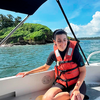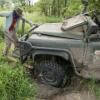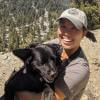With new technologies revolutionizing data collection, wildlife researchers are becoming increasingly able to collect data at much higher volumes than ever before. Now we are facing the challenges of putting this information to use, bringing the science of big data into the conservation arena. With the help of machine learning tools, this area holds immense potential for conservation practices. The applications range from online trafficking alerts to species-specific early warning systems to efficient movement and biodiversity monitoring and beyond.
However, the process of building effective machine learning tools depends upon large amounts of standardized training data, and conservationists currently lack an established system for standardization. How to best develop such a system and incentivize data sharing are questions at the forefront of this work. There are currently multiple AI-based conservation initiatives, including Wildlife Insights and WildBook, that are pioneering applications on this front.
This group is the perfect place to ask all your AI-related questions, no matter your skill level or previous familiarity! You'll find resources, meet other members with similar questions and experts who can answer them, and engage in exciting collaborative opportunities together.
Just getting started with AI in conservation? Check out our introduction tutorial, How Do I Train My First Machine Learning Model? with Daniel Situnayake, and our Virtual Meetup on Big Data. If you're coming from the more technical side of AI/ML, Sara Beery runs an AI for Conservation slack channel that might be of interest. Message her for an invite.
Header Image: Dr Claire Burke / @CBurkeSci

Explore the Basics: AI
Understanding the possibilities for incorporating new technology into your work can feel overwhelming. With so many tools available, so many resources to keep up with, and so many innovative projects happening around the world and in our community, it's easy to lose sight of how and why these new technologies matter, and how they can be practically applied to your projects.
Machine learning has huge potential in conservation tech, and its applications are growing every day! But the tradeoff of that potential is a big learning curve - or so it seems to those starting out with this powerful tool!
To help you explore the potential of AI (and prepare for some of our upcoming AI-themed events!), we've compiled simple, key resources, conversations, and videos to highlight the possibilities:
Three Resources for Beginners:
- Everything I know about Machine Learning and Camera Traps, Dan Morris | Resource library, camera traps, machine learning
- Using Computer Vision to Protect Endangered Species, Kasim Rafiq | Machine learning, data analysis, big cats
- Resource: WildID | WildID
Three Forum Threads for Beginners:
- I made an open-source tool to help you sort camera trap images | Petar Gyurov, Camera Traps
- Batch / Automated Cloud Processing | Chris Nicolas, Acoustic Monitoring
- Looking for help with camera trapping for Jaguars: Software for species ID and database building | Carmina Gutierrez, AI for Conservation
Three Tutorials for Beginners:
- How do I get started using machine learning for my camera traps? | Sara Beery, Tech Tutors
- How do I train my first machine learning model? | Daniel Situnayake, Tech Tutors
- Big Data in Conservation | Dave Thau, Dan Morris, Sarah Davidson, Virtual Meetups
Want to know more about AI, or have your specific machine learning questions answered by experts in the WILDLABS community? Make sure you join the conversation in our AI for Conservation group!
No showcases have been added to this group yet.
- @ImaniWilson
- | She / Her
Zoology with a placement year graduate from Bangor University. Interested in large African mammal movement and behaviour in response to climate change, particularly African elephants
- 0 Resources
- 0 Discussions
- 13 Groups
- @Fatuma
- | She/Her
I aim to transition my career towards conservation technology after gaining two years of experience in the tech industry.
- 0 Resources
- 0 Discussions
- 13 Groups
- @Heloise
- | She / Her
Bio-acoustician, marine biologist, marine mammal specialist, drone enthusiast
- 0 Resources
- 0 Discussions
- 9 Groups
- 0 Resources
- 0 Discussions
- 1 Groups
- @Ferrugem
- | They/Them
Latin American environmental scientist.
- 0 Resources
- 0 Discussions
- 2 Groups
- @TempleB
- | she
- 0 Resources
- 0 Discussions
- 1 Groups
- @katja
- | she/her
AI/ML consultant for climate/environment solutions industry
- 0 Resources
- 0 Discussions
- 5 Groups
- @karinnacvijanovich
- | she/her
- 0 Resources
- 1 Discussions
- 7 Groups
- @amklovrza
- | she / her
Hello! My name is Anabelle Marques Klovrza and I am a Ph.D. student at Dawson's lab. I am studying community assembly of island-like environments, and in trying to connect it with the vulnerability and fragility of the ecosystem.
- 0 Resources
- 0 Discussions
- 8 Groups
- @Giu.Appel
- | Her
Brazilian biologist, PhD in Ecology and 10 yrs of experience in the Amazon with bat bioacoustics
- 0 Resources
- 1 Discussions
- 5 Groups
- @Dominik
- | He/Him
PhD Student on bio- and ecoacoustics at the University of Freiburg (GER)
- 0 Resources
- 3 Discussions
- 2 Groups
I am nature lover and now lost the tolerance to just be an admirer watching its destruction. Hence joining this crew to contribute my supportive work much lesser than a penny worth
- 0 Resources
- 0 Discussions
- 3 Groups
Article
WildID is excited to share their new camera trap processing and detection tools with WILDLABS! Using machine learning to identify Southern African wildlife species in large quantities of camera trap data, WildID's tool...
8 March 2021
Edge Impulse is proud to announce their brand-new online course, Introduction to Embedded Machine Learning. Hosted on Coursera, this professional training course will provide beginners with the tools to started with...
9 February 2021
Last year, Tim van Deursen and Thijs Suijten shared their new "Hack the Poacher" system with us, presenting a unique way to detect poachers in real-time within protected national parks. Read on to learn about their...
29 January 2021
Our friends at Edge Impulse are proud to announce that they have become the first AI company to join 1% for the Planet, pledging to donate 1% of revenue to support nonprofit organizations focused on the environment. To...
15 January 2021
Scientists have found that studying high-resolution images of whales from space is a feasible way to estimate their populations. A team led by British Antarctic Survey (BAS) compared satellite images to data collected...
21 December 2020
WILDLABS community members are invited to submit an Expression of Interest to Fisheries Innovation Scotland (FIS) to participate in two research projects involving conservation tech's role in the future of sustainable...
8 December 2020
Hey Acoustic Monitoring and AI for Conservation community members - don't miss Rainforest Connection's Species Auto Detection Kaggle competition, open for to competitors and teams now! Participants will have the chance...
24 November 2020
Community Announcement
WILDLABS is celebrating its five year anniversary! Throughout the rest of 2020, we'll be sharing articles, community features, and case studies showcasing the incredible projects, collaborations, and successes that this...
17 November 2020
Do you have innovative #tech4wildlife ideas that could save one of the most endangered species on earth from extinction? Apply now to join Vaquita Hack, a hackathon for students and early career conservationists! This...
10 November 2020
In this article, Fulbright Scholar and National Geographic Explorer Kasim Rafiq discusses the potential to efficiently conduct wildlife surveys using cameras mounted to safari vehicles, as well as the workflow and AI...
10 November 2020
Today, Sustainable Fishing Challenges group leader Daniel Steadman discusses how fishing gear itself could benefit from fresh technological innovations to prevent both environmental damage and damage to species and...
19 August 2020
Funding
Protecting elephants from conservation's most pressing issues like poaching and human-wildlife conflict requires big, bold, and innovative solutions. Hackster.io, Smart Parks, Edge Impulse, Microsoft, and several other...
11 August 2020
August 2025
event
September 2025
event
event
event
event
October 2025
event
event
event
December 2025
event
March 2026
February 2023
event
event
January 2023
17 Products
Recently updated products
| Description | Activity | Replies | Groups | Updated |
|---|---|---|---|---|
| Hi everyone! My name is Leah Govia and I am a PhD candidate at the University of Guelph, Canada. My research explores what people... |
|
Ethics of Conservation Tech, Conservation Tech Training and Education, AI for Conservation | 1 year 6 months ago | |
| Hi Danilo. you seem very passionate about this initiative which is a good start.It is an interesting coincidence that I am starting another project for the coral reefs in the... |
|
Acoustics, AI for Conservation, Animal Movement, Camera Traps, Citizen Science, Climate Change, Community Base, Connectivity, Drones, Emerging Tech, Human-Wildlife Coexistence, Open Source Solutions, Sensors, Software Development, Wildlife Crime, Funding and Finance | 1 year 6 months ago | |
| I would recommend going with Ubiquity 2.4Ghz devices which have performed relatively well in dense foliage of the California Redwood forests. It took a lot of tweaking to... |
|
Acoustics, AI for Conservation, Connectivity, Open Source Solutions | 1 year 6 months ago | |
| Very nice video in the link you posted btw:Here is another less artistic one: |
|
Camera Traps, AI for Conservation | 1 year 7 months ago | |
| I'm also here for this. This is my first comment... I've been lurking for a while.I have 20 years of professional knowledge in design, with the bulk of that being software design... |
|
AI for Conservation, Camera Traps, Data management and processing tools, Software Development | 1 year 7 months ago | |
| Hi folks! Happy 2024 and thanks in advance for your patience in case I over-used tags. If you’re using any form of natural language... |
|
AI for Conservation, Citizen Science, Climate Change, Conservation Tech Training and Education, Data management and processing tools, Early Career, East Africa Community, Emerging Tech, Ending Wildlife Trafficking Online, Ethics of Conservation Tech, Human-Wildlife Coexistence, Open Source Solutions, Software Development, Wildlife Crime, Women in Conservation Tech Programme (WiCT) | 1 year 7 months ago | |
| BTW. I found out that the Jetson Orin NX 16GB module is drawing around 20W when running continuous inference, processing streams from 6x cameras at 6 fps.I'll try and find out... |
|
AI for Conservation | 1 year 7 months ago | |
| If you are considering an external microphone and a towed system, then you would also be in a position to consider a raspberry pi with an external microphone with sbts-aru.... |
|
Acoustics, AI for Conservation, Marine Conservation, Sustainable Fishing Challenges | 1 year 7 months ago | |
| @dmorris joined Variety Hour to give us 'a bunch of lightning talks inside a lightning talk'. Check out the recording to get a whirlwind... |
|
AI for Conservation, Drones, Geospatial | 1 year 8 months ago | |
| Also, take a look at TrapTagger. It has integration with WildMe. |
+4
|
AI for Conservation, Camera Traps | 1 year 8 months ago | |
| We are writing a methodology to measure Biodiversity density in habitats.Examining lots of different options but very keen to hear from... |
|
AI for Conservation | 1 year 9 months ago | |
| Hi @GermanFore ,I work with the BearID Project on individual identification of brown bears from faces. More recently we worked on face detection across all bear species and ran... |
|
AI for Conservation, Camera Traps, Data management and processing tools, Software Development | 1 year 9 months ago |





















































